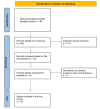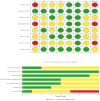Postoperative Anticoagulation After Mitral Bioprosthetic Valve Surgery: A Systematic Review and Meta-Analysis of Non-vitamin K Antagonist Oral Anticoagulants Versus Warfarin
- PMID: 40568296
- PMCID: PMC12192204
- DOI: 10.7759/cureus.84846
Postoperative Anticoagulation After Mitral Bioprosthetic Valve Surgery: A Systematic Review and Meta-Analysis of Non-vitamin K Antagonist Oral Anticoagulants Versus Warfarin
Abstract
The optimal anticoagulation strategy following mitral bioprosthetic valve replacement (BPVR) remains unclear. This meta-analysis evaluates the safety and efficacy of non-vitamin K antagonist oral anticoagulants (NOACs) compared to warfarin in this context. We systematically searched PubMed, Embase, Cochrane, and other databases for studies published between 2015 and 2025, comparing NOACs to warfarin in adults with mitral bioprostheses. Eligible studies reported thromboembolic and/or bleeding outcomes, with a minimum of six months' follow-up. Random-effects meta-analysis was performed, calculating odds ratios (ORs) with 95% confidence intervals (CIs). Heterogeneity was assessed using the I² statistic, and publication bias was assessed via funnel plot and Egger's test. Eight studies met the inclusion criteria, comprising 1,506 patients (709 on NOACs and 797 on warfarin). Included studies were randomized controlled trials (RCTs) and observational cohorts. NOACs studied were apixaban, rivaroxaban, and dabigatran. Three studies were included in the quantitative synthesis for each primary outcome. For stroke/systemic embolism, the pooled OR for NOACs was 0.57 (95% CI: 0.02-16.87, p = 0.55; I² = 33.7%). For major bleeding, the pooled OR was 1.06 (95% CI: 0.12-9.47, p = 0.94; I² = 74.9%). No significant publication bias was detected. Qualitative findings suggested NOACs had similar or lower rates of stroke, major and minor bleeding, and all-cause mortality. Valve thrombosis and rehospitalization were infrequently reported and comparable. NOACs appear to be a safe and effective alternative to warfarin after mitral BPVR. However, current evidence is limited by heterogeneity and wide CIs. Further large-scale RCTs are needed to confirm these findings.
Keywords: major bleeding complications; mitral bioprosthetic valve replacement; new oral anticoagulants (noacs); non-vitamin k antagonist oral anticoagulants; warfarin.
Copyright © 2025, Chaudhri et al.
Conflict of interest statement
Conflicts of interest: In compliance with the ICMJE uniform disclosure form, all authors declare the following: Payment/services info: All authors have declared that no financial support was received from any organization for the submitted work. Financial relationships: All authors have declared that they have no financial relationships at present or within the previous three years with any organizations that might have an interest in the submitted work. Other relationships: All authors have declared that there are no other relationships or activities that could appear to have influenced the submitted work.
Figures




Similar articles
-
Effectiveness and Safety of Non-vitamin K Antagonist Oral Anticoagulants for Atrial Fibrillation and Venous Thromboembolism: A Systematic Review and Meta-analyses.Clin Ther. 2017 Jul;39(7):1456-1478.e36. doi: 10.1016/j.clinthera.2017.05.358. Epub 2017 Jun 28. Clin Ther. 2017. PMID: 28668628
-
Oral anticoagulants for primary prevention, treatment and secondary prevention of venous thromboembolic disease, and for prevention of stroke in atrial fibrillation: systematic review, network meta-analysis and cost-effectiveness analysis.Health Technol Assess. 2017 Mar;21(9):1-386. doi: 10.3310/hta21090. Health Technol Assess. 2017. PMID: 28279251 Free PMC article.
-
Interrupted versus uninterrupted anticoagulation therapy for catheter ablation in adults with arrhythmias.Cochrane Database Syst Rev. 2021 Oct 21;10(10):CD013504. doi: 10.1002/14651858.CD013504.pub2. Cochrane Database Syst Rev. 2021. PMID: 34674223 Free PMC article.
-
Antiplatelet and anticoagulant agents for secondary prevention of stroke and other thromboembolic events in people with antiphospholipid syndrome.Cochrane Database Syst Rev. 2017 Oct 2;10(10):CD012169. doi: 10.1002/14651858.CD012169.pub2. Cochrane Database Syst Rev. 2017. Update in: Cochrane Database Syst Rev. 2020 Oct 12;10:CD012169. doi: 10.1002/14651858.CD012169.pub3. PMID: 28968483 Free PMC article. Updated.
-
Antithrombotic therapy for ambulatory patients with multiple myeloma receiving immunomodulatory agents.Cochrane Database Syst Rev. 2021 Sep 28;9(9):CD014739. doi: 10.1002/14651858.CD014739. Cochrane Database Syst Rev. 2021. PMID: 34582035 Free PMC article.
References
-
- ACC/AHA guideline for the management of patients with valvular heart disease: a report of the American College of Cardiology/American Heart Association Joint Committee on clinical practice guidelines. Otto CM, Nishimura RA, Bonow RO, et al. Circulation. 2021;143:0. - PubMed
-
- Burden of valvular heart diseases: a population-based study. Nkomo VT, Gardin JM, Skelton TN, Gottdiener JS, Scott CG, Enriquez-Sarano M. Lancet. 2006;368:1005–1011. - PubMed
Publication types
LinkOut - more resources
Full Text Sources
Miscellaneous
